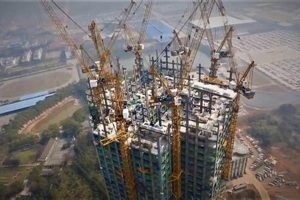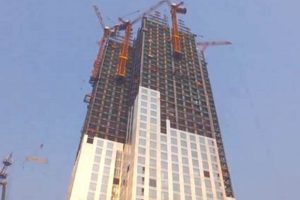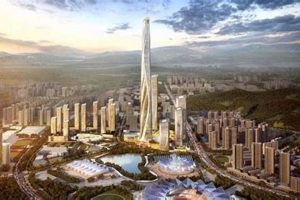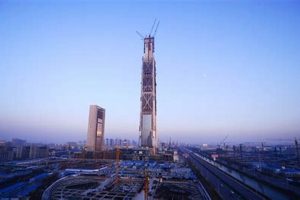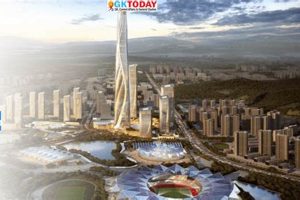Skyscrapers in Milan are high-rise buildings that are designed to house a variety of commercial, residential, and hospitality uses. Many of the skyscrapers in Milan are located in the city’s central business district, known as the Porta Nuova district. This area is home to some of the city’s most iconic skyscrapers, including the Unicredit Tower, the Generali Tower, and the Pirelli Tower. These skyscrapers are not only landmarks in Milan but also important contributors to the city’s economy.
Skyscrapers in Milan are important for several reasons. First, they provide much-needed office space for the city’s growing business community. Second, they help to create a more vibrant and cosmopolitan cityscape. Third, they can be a source of civic pride for the city’s residents. The construction of skyscrapers in Milan has a long history. The first skyscraper in the city was the Torre Velasca, which was completed in 1958. Since then, many other skyscrapers have been built in Milan, including the aforementioned Unicredit Tower, Generali Tower, and Pirelli Tower. These skyscrapers are a testament to the city’s economic vitality and its commitment to innovation.
There are many different types of skyscrapers in Milan. Some are designed to be primarily office buildings, while others are mixed-use developments that include residential units, retail space, and even hotels. The tallest skyscraper in Milan is the Unicredit Tower, which stands at 231 meters (758 feet) tall. Other notable skyscrapers in Milan include the Generali Tower, the Pirelli Tower, and the Torre Velasca. These skyscrapers are all unique in their own way, but they all share a common goal: to contribute to the city’s skyline and economy.
1. Height
The height of Milan skyscrapers is a key aspect of their importance and significance. The Unicredit Tower, the tallest skyscraper in Milan, is also the tallest building in Italy. This makes it a prominent landmark and a symbol of the city’s economic power. The height of Milan skyscrapers also allows them to provide stunning views of the city and the surrounding countryside. Many of the city’s skyscrapers have rooftop terraces or observation decks that are open to the public, offering visitors a chance to experience the city from a unique perspective.
The height of Milan skyscrapers is also a major factor in their sustainability. Tall buildings are more efficient in terms of energy consumption and land use. They can also be designed to incorporate green features, such as solar panels and rainwater harvesting systems. The Unicredit Tower, for example, is LEED Platinum certified, which means that it meets the highest standards of environmental performance.
The height of Milan skyscrapers is a key part of what makes them so important to the city. They are a symbol of the city’s economic vitality and its commitment to innovation and progress.
2. Architecture
Milan skyscrapers are known for their innovative and stylish architecture. Many of the city’s skyscrapers were designed by world-renowned architects, such as Renzo Piano and Cesar Pelli.
The architecture of Milan skyscrapers is an important part of what makes them so iconic. The city’s skyscrapers are known for their sleek and modern designs. Many of them incorporate sustainable features, such as green roofs and solar panels. The architecture of Milan skyscrapers also reflects the city’s rich cultural heritage. Many of the city’s skyscrapers are inspired by traditional Italian architecture.
The architecture of Milan skyscrapers is not only aesthetically pleasing, but it is also functional. The city’s skyscrapers are designed to be efficient and comfortable. They are also designed to be safe and secure. The architecture of Milan skyscrapers is a key part of what makes them so important to the city.
Here are some examples of the innovative and stylish architecture of Milan skyscrapers:
- The Unicredit Tower, designed by Cesar Pelli, is the tallest building in Italy. It is known for its unique sail-like design.
- The Torre Velasca, designed by BBPR, is one of the most iconic skyscrapers in Milan. It is known for its mushroom-shaped design.
- The Pirelli Tower, designed by Gio Ponti, is another iconic skyscraper in Milan. It is known for its elegant and timeless design.
The architecture of Milan skyscrapers is a testament to the city’s commitment to innovation and progress. The city’s skyscrapers are an important part of its skyline and its economy.
3. Location
The location of Milan skyscrapers in the city’s central business district is a key factor in their importance and significance. The Porta Nuova district is the heart of Milan’s financial and commercial activity. It is home to the city’s stock exchange, as well as the headquarters of many of Italy’s largest banks and corporations.
- Proximity to key businesses and institutions: The location of Milan skyscrapers in the Porta Nuova district gives them easy access to the city’s most important businesses and institutions. This proximity is essential for the city’s financial and commercial sectors.
- Access to transportation: The Porta Nuova district is well-connected to public transportation, making it easy for employees and visitors to access Milan skyscrapers. The district is also close to Milan’s main train station, making it easy for people to travel to and from the city.
- Prestige and visibility: The Porta Nuova district is one of the most prestigious and visible areas in Milan. This makes it an ideal location for companies that want to project an image of success and stability.
- Economic development: The location of Milan skyscrapers in the Porta Nuova district has helped to drive economic development in the area. The district is now home to a number of new businesses and developments, which has created jobs and boosted the local economy.
The location of Milan skyscrapers in the Porta Nuova district is a key part of what makes them so important to the city. They are a symbol of the city’s economic vitality and its commitment to innovation and progress.
4. Sustainability
Sustainability is an important aspect of Milan skyscrapers. Many of the city’s skyscrapers are designed to be environmentally friendly and efficient. This is important for several reasons.
- Environmental impact: Skyscrapers can have a significant environmental impact. They can consume large amounts
of energy and water, and they can produce greenhouse gases. Sustainable skyscrapers are designed to minimize their environmental impact by using energy-efficient technologies, water-saving fixtures, and recycled materials. - Economic benefits: Sustainable skyscrapers can also be more economical to operate. They can save money on energy and water costs, and they can attract tenants who are looking for green buildings.
- Tenant demand: There is a growing demand for sustainable buildings. Tenants are increasingly looking for buildings that are environmentally friendly and healthy. Sustainable skyscrapers can meet this demand and attract high-quality tenants.
The Unicredit Tower is a good example of a sustainable skyscraper. The tower is LEED Platinum certified, which means that it meets the highest standards of environmental performance. The tower uses a number of green features, such as a rainwater harvesting system, solar panels, and a green roof. These features help to reduce the tower’s environmental impact and make it more sustainable.
The sustainability of Milan skyscrapers is a key part of what makes them so important to the city. Sustainable skyscrapers help to reduce the city’s environmental impact, they can be more economical to operate, and they can attract high-quality tenants. As the demand for sustainable buildings continues to grow, Milan skyscrapers will continue to play an important role in the city’s future.
5. Mixed-use
Mixed-use skyscrapers are an important part of Milan’s urban fabric. They help to create a more vibrant and sustainable cityscape by bringing together different types of uses in one place. This can help to reduce traffic congestion, air pollution, and energy consumption. Mixed-use skyscrapers can also help to create a more diverse and inclusive community by providing a variety of housing options and amenities for people of all ages and incomes.
There are many examples of mixed-use skyscrapers in Milan. One of the most iconic is the Torre Velasca, which was completed in 1958. The Torre Velasca is a 26-story skyscraper that includes office space, residential units, and retail space. Another example is the Unicredit Tower, which was completed in 2012. The Unicredit Tower is a 31-story skyscraper that includes office space, residential units, and a hotel.
The trend towards mixed-use skyscrapers is growing in Milan and other cities around the world. As cities become more crowded and congested, mixed-use skyscrapers offer a sustainable and efficient way to accommodate a growing population.
There are many benefits to mixed-use skyscrapers. They can help to reduce traffic congestion, air pollution, and energy consumption. They can also help to create a more diverse and inclusive community by providing a variety of housing options and amenities for people of all ages and incomes. Mixed-use skyscrapers are an important part of the future of Milan and other cities around the world.
6. Economic impact
Skyscrapers are a major part of the Milan economy. They provide much-needed office space for the city’s growing business community, and they also help to attract tourists and investment to the city. Here are a few of the ways that Milan skyscrapers contribute to the city’s economy:
- Office space: Milan skyscrapers provide much-needed office space for the city’s growing business community. The city is home to a number of large corporations, and skyscrapers provide them with the space they need to operate and grow.
- Tourism: Milan skyscrapers are also a major tourist attraction. The city’s skyline is one of the most iconic in the world, and tourists come from all over the globe to see it. Skyscrapers are also home to a number of popular tourist destinations, such as the Duomo di Milano and the Galleria Vittorio Emanuele II.
- Investment: Milan skyscrapers are also a major draw for investment. The city is a major financial center, and skyscrapers are seen as a safe and profitable investment. This investment helps to create jobs and boost the city’s economy.
The economic impact of Milan skyscrapers is significant. They provide much-needed office space, attract tourists, and draw investment. This helps to create jobs, boost the city’s economy, and make Milan a more prosperous city.
7. Cultural significance
Milan skyscrapers are not just buildings; they are symbols of the city’s economic vitality, cultural heritage, and commitment to innovation. They are a source of pride for the people of Milan and a major tourist attraction. Here are a few of the ways that Milan skyscrapers contribute to the city’s culture and identity:
- Architectural heritage: Milan skyscrapers are a major part of the city’s architectural heritage. They represent the city’s commitment to design and innovation. Many of Milan’s skyscrapers were designed by world-renowned architects, such as Renzo Piano and Cesar Pelli. These buildings are not just functional; they are also works of art.
- Economic vitality: Milan skyscrapers are a symbol of the city’s economic vitality. They provide much-needed office space for the city’s growing business community. The presence of these skyscrapers has helped to attract investment and create jobs in Milan.
- Cultural identity: Milan skyscrapers are a major part of the city’s cultural identity. They are a symbol of the city’s ambition and its commitment to progress. The people of Milan are proud of their skyscrapers, and they see them as a reflection of the city’s spirit.
Milan skyscrapers are more than just tall buildings; they are symbols of the city’s culture, economy, and identity. They are a source of pride for the people of Milan and a major tourist attraction. Milan skyscrapers are an important part of what makes Milan a unique and dynamic city.
FAQs About Milan Skyscrapers
Skyscrapers are an essential part of the Milan skyline. They provide office space, residential units, and retail space, and are a major contributor to the city’s economy. Here are some frequently asked questions about Milan skyscrapers:
Question 1: What is the tallest skyscraper in Milan?
Answer: The tallest skyscraper in Milan is the Unicredit Tower, which stands at 231 meters (758 feet) tall.
Question 2: Who designed the Unicredit Tower?
Answer: The Unicredit Tower was designed by Argentine-American architect Cesar Pelli.
Question 3: When was the first skyscraper built in Milan?
Answer: The first skyscraper built in Milan was the Torre Velasca, which was completed in 1958.
Question 4: How many skyscrapers are there in Milan?
Answer: There are over 100 skyscrapers in Milan.
Question 5: What is the most sustainable skyscraper in Milan?
Answer: The Unicredit Tower is the most sustainable skyscraper in Milan. It is L
EED Platinum certified, which means that it meets the highest standards of environmental performance.
Question 6: What is the most iconic skyscraper in Milan?
Answer: The most iconic skyscraper in Milan is the Torre Velasca. It is known for its unique mushroom-shaped design.
These are just a few of the most frequently asked questions about Milan skyscrapers. For more information, please visit the official website of the City of Milan.
Skyscrapers are an important part of the Milan skyline and economy. They are a symbol of the city’s commitment to innovation and progress.
Transition to the next article section
Tips for Visiting Milan Skyscrapers
Milan skyscrapers offer stunning views of the city and are a must-see for any visitor. Here are a few tips to make the most of your visit:
Tip 1: Purchase a CityPASS. A CityPASS gives you access to some of Milan’s most popular attractions, including the Duomo, the Sforza Castle, and the Pinacoteca di Brera. It also includes a ticket for the hop-on hop-off bus, which is a great way to get around the city and see the skyscrapers.
Tip 2: Visit the skyscrapers at different times of day. The skyscrapers look different depending on the time of day. Visit them at sunrise, sunset, and night to see them in their best light.
Tip 3: Take the elevator to the top of one of the skyscrapers. The views from the top of the skyscrapers are incredible. Be sure to take your camera so you can capture the stunning views.
Tip 4: Have dinner at a restaurant with a view of the skyscrapers. Several restaurants in Milan offer stunning views of the skyscrapers. It’s a great way to enjoy the city’s skyline while having a delicious meal.
Tip 5: Visit the skyscrapers during the holidays. The skyscrapers are decorated for the holidays, making them even more beautiful. It’s a great time to visit Milan and see the city in its festive best.
Summary:
Milan skyscrapers offer unforgettable experiences and awe-inspiring views. Consider these tips to maximize your journey and cherish the architectural wonders of Milan.
Transition to the article’s conclusion:
Milan Skyscrapers
Milan skyscrapers are an essential part of the city’s skyline and economy. They provide much-needed office space, residential units, and retail space. They are also a major tourist attraction and a symbol of the city’s commitment to innovation and progress.
The first skyscraper in Milan was the Torre Velasca, which was completed in 1958. Since then, many other skyscrapers have been built in Milan, including the Unicredit Tower, the Generali Tower, and the Pirelli Tower. These skyscrapers are all unique in their own way, but they all share a common goal: to contribute to the city’s skyline and economy.
The construction of skyscrapers in Milan has helped to make the city a major financial and business center. The city is now home to many of Italy’s largest banks and corporations. Skyscrapers have also helped to attract tourists to Milan. The city’s skyline is one of the most iconic in the world, and tourists come from all over the globe to see it.
Milan skyscrapers are more than just tall buildings; they are symbols of the city’s economic vitality and cultural heritage. They are a source of pride for the people of Milan and a major tourist attraction. Milan skyscrapers are an important part of what makes Milan a unique and dynamic city.
As Milan continues to grow and develop, its skyscrapers will continue to play an important role in the city’s future. They will continue to provide much-needed office space and residential units, and they will continue to attract tourists and investment to the city. Milan skyscrapers are a symbol of the city’s commitment to innovation and progress, and they will continue to be an important part of the city’s skyline for many years to come.


